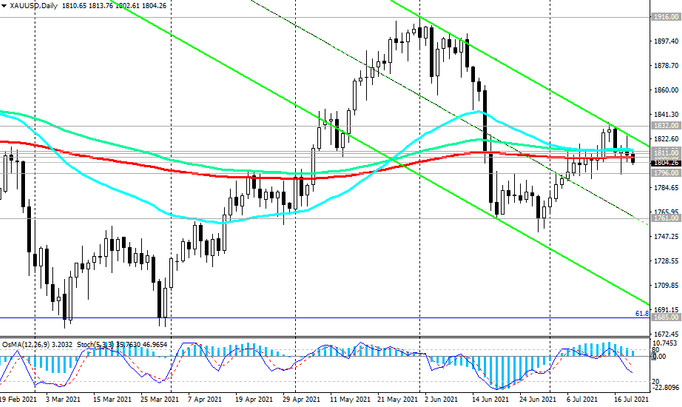In the absence of the publication of important macro data in today's economic calendar, the dollar continues to gradually strengthen in the foreign exchange market. The DXY dollar index is growing today for the 5th trading day and the 2nd trading week in a row, reaching another 16-week high today near 93.20 mark.
The most important event of this week is tomorrow's ECB meeting. We briefly wrote about it in our yesterday's review. But the central event of the next week will be the Fed meeting, which will end on July 28 with the publication (at 18:00 GMT) of the decision on the interest rate. As you know, following the results of the previous (June) meeting on monetary policy, the Fed leaders kept key interest rates in the range of 0.00% -0.25%, and the volume of the QE asset purchase program remained at the same level of $ 120 billion per month.
The accompanying statement said that the Fed will continue to adhere to the current parameters of monetary policy until the target levels for inflation and maximum employment are reached, reiterating that the level of interest rates will not change.
However, the Fed is now forecasting two rate hikes in 2023, while earlier central bank officials had pledged not to raise rates until the end of 2023.
13 of the 18 central bank leaders said they expect short-term interest rates to rise by the end of 2023, up from just 7 in March. Already 7 representatives of the FOMC against 4 in March expect the start of rate hikes already in 2022.
At a press conference following the June meeting, US Federal Reserve Chairman Jerome Powell did not say when the curtailment of asset purchases could begin, reiterating that the Fed will warn about any changes in advance. "The timing, of course ... will depend on the degree of our progress, and not on any calendar", - he said.
Central bank leaders want to push the economy closer to "peak employment" and to a stable annual inflation of 2.0% before phasing out asset purchases. According to them, these goals must be achieved before the regulator moves on to raise rates.
Speaking to Congress last week, Powell reiterated that there is still a long way to go before reducing monetary stimulus, as the labor market is still far from pre-pandemic levels. In his opinion, the rise in inflation is a short-term phenomenon, and "the time has not yet come for the reduction of incentives".
However, he and other Fed leaders are finding it increasingly difficult to contain the dollar's strengthening. US inflation is growing at the fastest pace in nearly 30 years (US inflation data released earlier this month was above expectations: CPI rose +0.9% in June (+5.4% YoY) and inflation expectations jumped to 4.8% (from 4% in May), which is a record high), and the Fed will still have to respond to this by starting to cut the stimulus program or raise interest rates. If this is the case, then those investors who are already starting to build up long positions in the dollar will be right.
Although the prevailing opinion is that at the July meeting the FRS will not change the parameters of the current monetary policy, nevertheless, the intrigue remains. Fed officials could signal their readiness in the coming months to begin discussing the possibility of scaling back stimulus policies.
Gold quotes behave characteristically in this situation. The XAU / USD pair has been in a waiting position for the second week in a row, trading in a narrow range near the current mark of 1808.00, through which the key long-term support / resistance level passes (see Technical Analysis and Trading Recommendations).

Gold does not generate investment income, but its quotes are extremely sensitive to changes in the interest rates of the Fed and other major central banks in the world.
On the one hand, growing inflation and a more aggressive delta strain of coronavirus spreading around the world create prerequisites for the growth of the XAU / USD pair. On the other hand, investors seem to be refraining from building up long positions in gold for the time being in anticipation of the outcome of the Fed meeting next week. If the rhetoric of the Fed leaders ' statements regarding rising inflation indicates their readiness for an earlier start of curtailing the stimulus policy, this may be a signal for a more aggressive closing of short positions on the dollar and for the sale of the XAU/USD pair.





